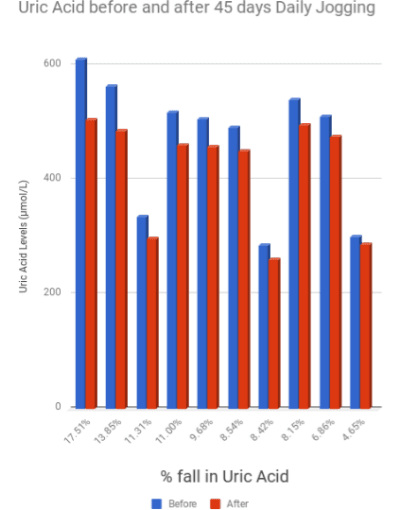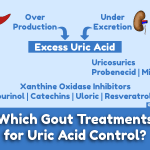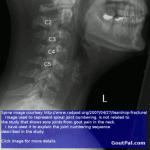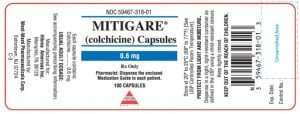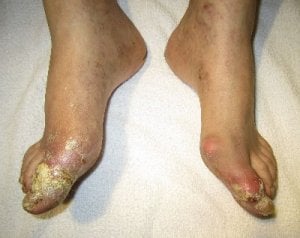A gout sufferer asked, “Do endurance athletes get gout?”
But this simple question started a long discussion. Because we do not have much research about the effects of exercise on gout. So I’ve started to collect research as it is published. Then you can keep track of the latest scientific facts about gout and exercise.
Always remember, exercise is an important part of gout diet. But exercise, by itself, is only one part of a complex series of processes that affect gout in different ways. So you need to consider where you are at, and where you are going.
Before I look at exercise, you must remember what gout is – a uric acid imbalance where excess uric acid forms crystals in joints and other body tissues. Of itself, and contrary to popular belief, it is not a dietary problem, though bad diet can make gout worse, and occasionally it is the only source of excess uric acid.
There is an important test when first diagnosed with gout. But before uric acid treatment starts. That test involves collecting urine over a 24-hour period, which is then analyzed for uric acid output. This tells you if you are an over-producer or under-excreter. With this knowledge, managing exercise & gout together becomes easier. Whether you get this test or not, uric acid blood tests are vital. Exercise can affect gout in different ways, and if you do not know your precise uric acid level (a number, not a label), you will not be able to judge the benefits or pitfalls from your exercise program.
Gout and Strenuous Exercise
Now, this article is concerned with athletic endurance and strenuous exercise. We know that gentle exercise is good for gout, as it improves mobility without the added complication of raised uric acid from exercise stress[1]. So does this mean that strenuous exercise is bad for gout?
Like many aspects of gout management, managing gout & exercise is not about good and bad, or right and wrong, it is about balance. It is about balancing your physical and psychological need for exercise against inherent risks. We have seen, from the first study, that there is a risk of increased uric acid from strenuous exercise. However, that report also indicates that these effects can be avoided. Individuals who know that their uric acid excretion is not impaired will also benefit from staying hydrated during, or immediately after, strenuous exercise.
In a later article, I will look at specific benefits of exercise reported for gout sufferers. A statistical study offers some insight into the benefits of exercise[2]. In that report, men running 5 miles per day had 50% less incidence of gout than the least active men.
Though statistical studies need careful interpretation, this is supported by other specific studies that I will summarize later. There seems little doubt that exercise will benefit most gout sufferers, but it is pointless in isolation. If you have ever had a gout attack, the maximum safe level for uric acid in your blood is 5 mg/dL (0.30mmol/L). Exercise might help you achieve this, but you must take uric acid treatment if necessary to maintain that safe level. If you do not, the crystals will build up and erode bone, cartilage, and tendon.
Gout & Exercise: Next Steps
Exercise your mind and control your uric acid, before the deposits cripple you and permanently deprive you of physical exercise.
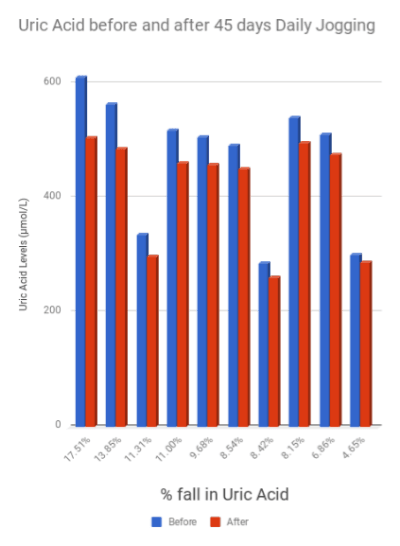
2018 Gout and Exercise Update
New research indicates that long-term aerobic exercise lowers uric acid by increasing ATP (Adenosine TriPhosphate) turnover[3].
1–2 times exercise (1600 m jogging with a speed of 35–60 s per 100 m) cannot reduce the uric acid level significantly. So we designed a long-term exercise project for some patients before the age of 60. After 45 days of jogging (every day), uric acid decreased.
I will continue to monitor this research, and report more detail as it becomes available. So if you would like an email when I publish more information:
Leave this Gout & Exercise page to browse the Gout Diet Section.
Gout and Exercise Feedback
GoutPal visitor responses include:
Gout and Activity
A gout forum member shared the following quote about gout and activity…
It is concluded that exercise intensity rather than total work output is a critical factor mediating increases in blood uric acid concentration. These results are consistent with the interpretation that uric acid formation may arise from purine nucleotide degradation and fast-twitch fiber utilization during conditions of high energy utilization. [4]
Exercise Intensity and Uric Acid
Thank you for that reference to a uric acid and exercise intensity study. I will review it for the next update of this page. If anyone else has questions, experiences, or opinions that might help improve this page, please share in the feedback form below.
Gout & Exercise Related Topics
Please remember: to find more related pages that are relevant to you, use the search box near the top of every page.
Common Terms: tendon
Other posts that include these terms:
- Gout & Rheumatoid Arthritis
- Uric Acid Arthritis – Another Name For Gout
- Do you know 9 Golden Rules of Gout Management?
- Left Foot Tophi Study with Photographs
- Running With Gout – Beware Foot Tendon Damage
- Gouty Tophi & Bone Erosion
- Gout in Shoulder
Gout & Exercise References
- Treating Raised Uric Acid From Exercise Stress
- Gout And Athletic Endurance
- Yuan, Shu, Zhong-Wei Zhang, and Zi-Lin Li. “Antacids’ side effect hyperuricaemia could be alleviated by long-term aerobic exercise via accelerating ATP turnover rate.” Biomedicine & Pharmacotherapy 99 (2018): 18-24. Daily Jogging Reduces Uric Acid PDF.
- Green, HOWARD J., and I. G. Fraser. “Differential effects of exercise intensity on serum uric acid concentration.” Medicine and science in sports and exercise 20, no. 1 (1988): 55-59.
Please give your feedback
Did this page help you? If yes, please consider a small donation. Your donations help keep GoutPal's gout support services free for everyone.
If not, please tell me how I can improve it to help you more.
- YouTube
- The gout forums.
